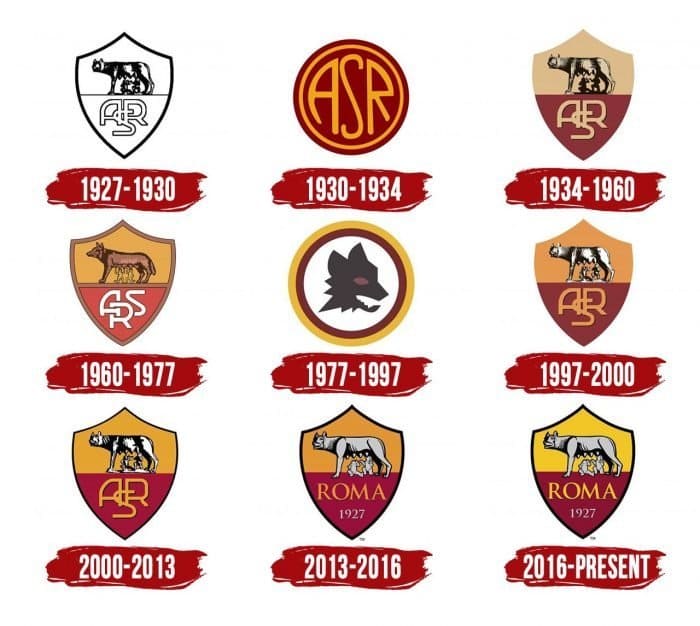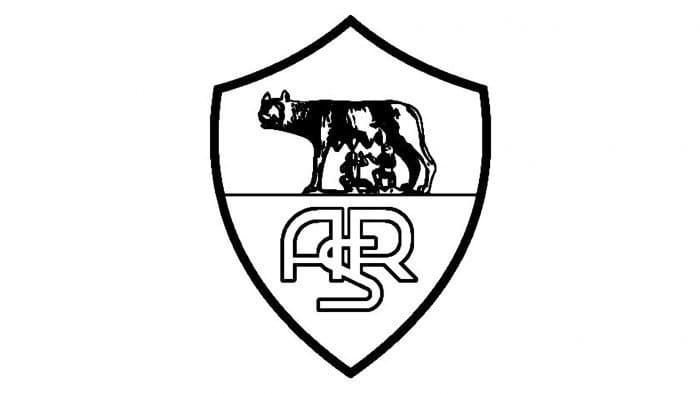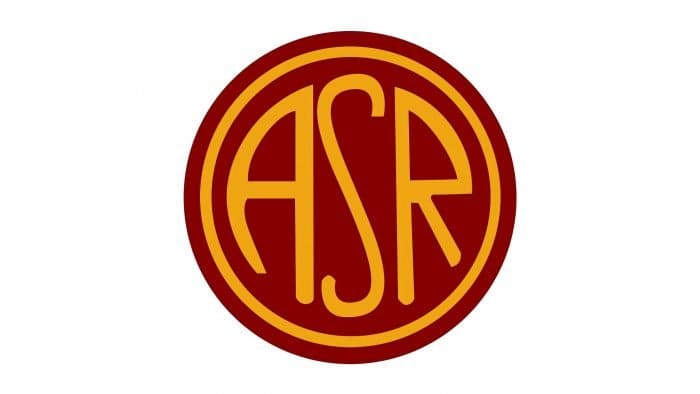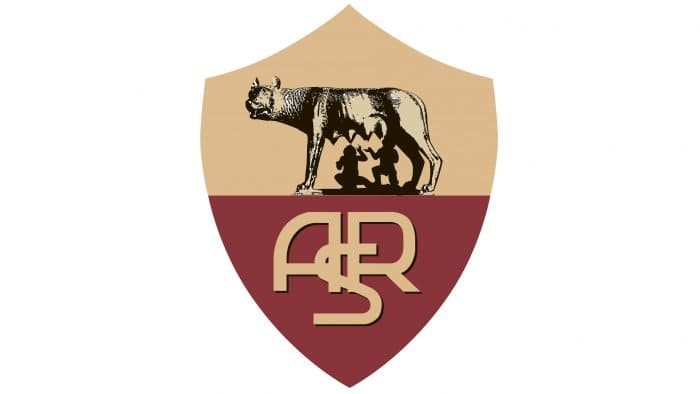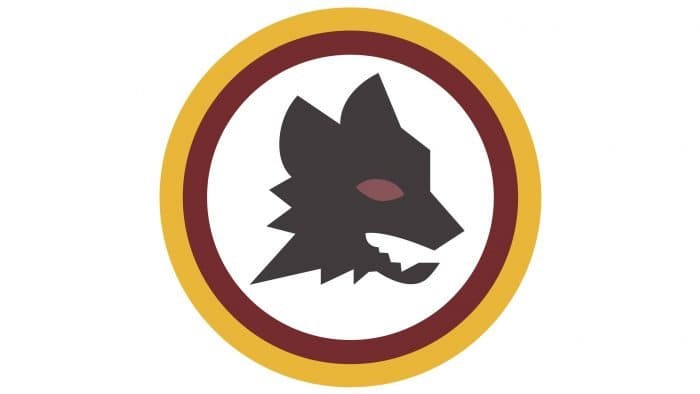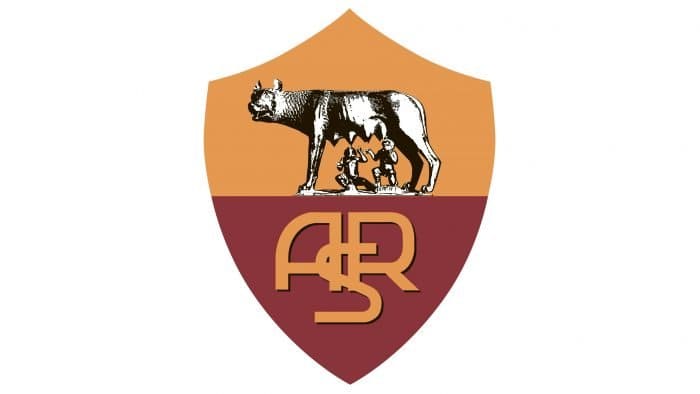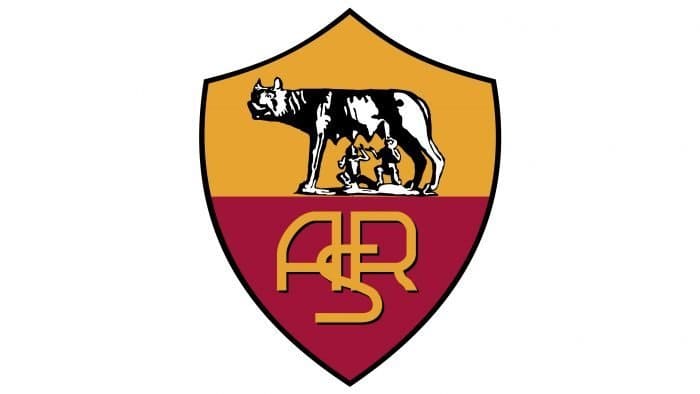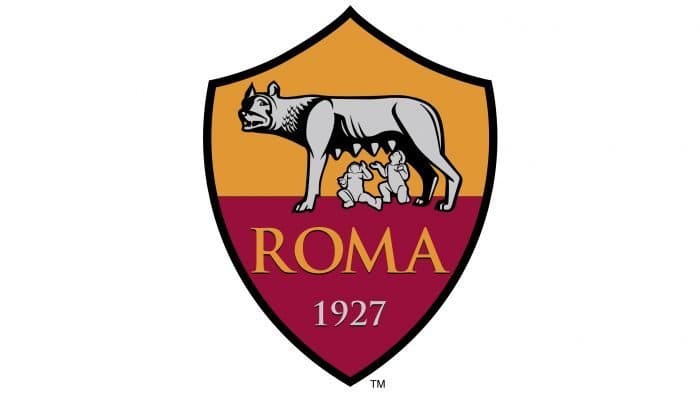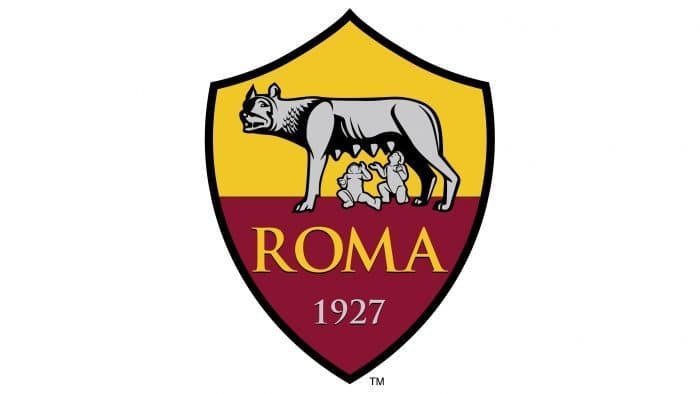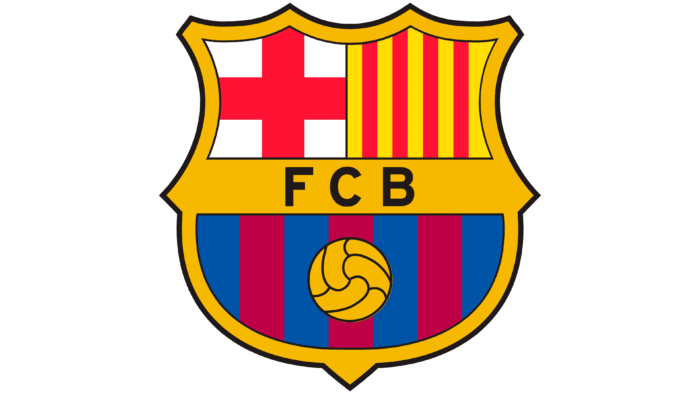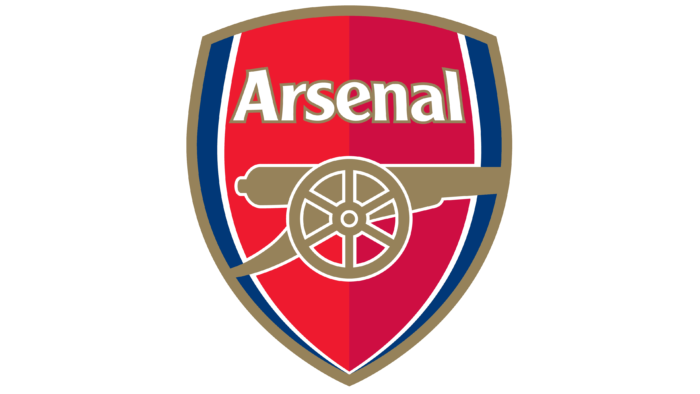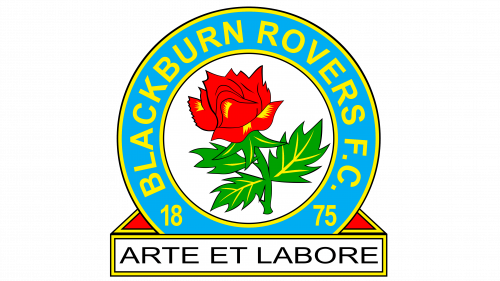The commitment to its interesting history and emphasis on national identity is demonstrated in the logo of the Italian football club “Roma.” The heraldic shield and city symbols reflect the characteristic Roman spirit of the team, striving to be worthy of its emblem.
Roma: Brand overview
| Founded: | 7 June 1927 |
| Founder: | The Friedkin Group |
| Headquarters: | Rome, Italy |
| Website: | asroma.com |
Meaning and History
The history of the creation of the logo is almost the same. The managers of the new club took the already existing logo of the Fortitude club. However, the emblem seemed most suitable to the club, and this fact could not be ignored.
The “Roma” emblem consists of two parts: the top features the Capitoline wolf, and the bottom displays the ASR logo (Associazione Sportiva Roma – Sport Association of Rome). The Capitoline she-wolf is one of the main symbols of the Eternal City. According to legend, Romulus and Remus, the founders of Rome, were raised by a she-wolf, which became the sacred animal of the city.
The colors of the emblem were taken from the Roman flag: the gold color symbolized the gods, and the red-brown symbolized the emperors. Roman legionnaires also wore yellow and red colors.
Indeed, since then, the Roma logo has undergone minor changes. Over the years, “Roma” received the nickname “wolves,” which led the club to a radical change of the emblem in the 80s. Now, the “Roma” jerseys featured an image containing the face of a wolf. It was quite cute and, at the same time, aggressive.
Moreover, the team itself was performing quite well at that time. However, fans missed the wolf with Romulus and Remus. Thus, in the 90s, the old “Roma” logo returned to the jerseys. After this, there were minor changes in the arrangement of letters and their font, but the essence remained the same, and “Roma” is the main club of Rome, following the great traditions of the Eternal City.
So, overall, these are all the elements of the current emblem of “Roma.” It’s unlikely we’ll see something new any time soon unless Francesco Totti joins the silhouettes of Romulus and Remus.
What is Roma?
“Roma” is an Italian sports association from Italy, uniting professional footballers. It has existed since 1927, when a historic merger of four teams occurred. The club has repeatedly won titles in Coppa Italia and Supercoppa Italiana and has topped Serie A three times. It was founded by Italo Foschi. The club’s headquarters is located in the city of Rome. Its home stadium is “Stadio Olimpico”.
1927 – 1930
The first emblem of “Roma” was dedicated to the sculpture called Lupa Capitolina. The image of the animal feeding the twins Remus and Romulus was inside a white heraldic shield with a black contour. Right below the drawing was a monogram of the letters “A,” “S,” and “R” (Associazione Sportiva Roma).
In the late 1920s, this graphic sign could be encountered almost everywhere, including on season tickets. It just wasn’t on the players’ uniforms. However, it should be noted that the football club did not have official permission to use the city’s historical sculpture in its emblem, so it had no legal rights to it.
1930 – 1934
At the beginning of the 1930s, an emblem appeared that became the first “decoration” of the players’ uniforms. The red circle with the yellow inscription “ASR” looked simple but interesting: the letters were compressed to fit into the ring. The presented color combination is considered classic for Roma today.
1934 – 1960
The period that began at the end of the 1930s and lasted the next 30 years was quite unstable. Initially, designers created a logo in the form of a shield with a large monogram divided into two parts. Until 1943, it was used only for away matches.
Concurrently, there was another emblem: a shield with the Capitoline wolf and the club’s initials. It was almost the same as the 1927 version, but the artists added more color. This graphic symbol never appeared on the players’ uniforms.
1960 – 1977
The image was changed: the drawing with the she-wolf stopped resembling the original sculpture, and the shield received a light brown outline. The letters in the monogram became white and scattered.
1977 – 1997
A modernized logo with a wolf’s head inside a circle appeared in 1978. Before, it symbolized the city’s history, but now it has become more market-oriented. The designers had one goal – to develop a trademark that would effectively promote the Roma brand in the market and stimulate the sale of products.
1997 – 2000
In 1997, the club returned to its roots, reviving the old emblem with Lupa Capitolina. But this time, they acted smarter and previously obtained permission from the city authorities to use the image of the statue. Thus, the she-wolf nursing Remus and Romulus legally “settled” on the heraldic shield.
2000 – 2013
In the new millennium, a black outline appeared around the shield, and the main colors became a bit brighter.
2013 – 2016
In 2011, the club was acquired by a group of owners from the USA. The new owners initiated a logo change, which occurred in 2013. Designers changed the drawing style, so the image of the Capitoline she-wolf stopped resembling the original statue. Dissatisfied fans called it an act of vandalism and harshly criticized the innovation. Against this backdrop, other changes were minor. Developers replaced the monogram with the word “Roma,” and in the lower corner of the shield, they placed the club’s founding year: 1927.
2016 – today
Another redesign was carried out in 2016. To the disappointment of fans, the artists did not return the classic Capitoline she-wolf. Instead, they made minor adjustments to the color palette, using yellow instead of orange.
Roma: Interesting Facts
Associazione Sportiva Roma, often called AS Roma, is a big soccer team from Italy with a long and important history.
- How It Started: AS Roma was created in 1927 by combining three clubs. The government encouraged this to make a strong team in Rome that could compete with teams from northern Italy.
- Team Colors and Symbol: The team wears purple and gold, which is unique. Their symbol is a she-wolf, like from the story of how Rome was founded, showing the team’s strong ties to the city’s history.
- Home Stadium: They play at the Stadio Olimpico, which they share with their city rivals Lazio. This famous stadium has hosted big events, like the 1960 Olympics.
- Big Rivalry: Their games against Lazio, called the Derby della Capitale, are big and passionate. It’s one of the most exciting matchups in soccer.
- Winning the League: They won their first Serie A (Italian league) title in 1942 and have won a few more times since then, but not as often as they’d like.
- European Competitions: They reached the final of the European Cup (now called the UEFA Champions League) in 1984 but lost to Liverpool. They also won the Inter-Cities Fairs Cup in 1961.
- Famous Players: Some of soccer’s greats have played for Roma, like Francesco Totti, who scored the most goals and played the most games for the team, and Daniele De Rossi.
- New Owner: In 2020, an American businessman named Dan Friedkin bought the team, aiming to bring new success and stability.
- Training Young Players: Roma is good at training young players in their academy, helping them become stars in Italy and other countries.
- Impact Beyond Soccer: Roma means a lot to the people of Rome and has fans all over. They also do good things for the community, like fighting racism and helping refugees.
AS Roma’s story includes big games, famous players, and a strong connection to Rome, making it a beloved soccer club in Italy and worldwide.
Font and Colors
The main element of Roma’s visual identification is the she-wolf nursing Romulus and Remus. According to legend, one of these twins grew up and founded the city that later became the capital of Italy. Moreover, the logo features not just mythical characters but the famous statue of Lupa Capitolina. Its original is kept in the Capitoline Museum, and numerous copies are scattered around the world.
Thus, the emblem of the football team is directly linked to the cultural and historical heritage of its homeland. This is the most “Roman” thing the designers could come up with.
In the modern emblem, the same font is used as in the period from 2013 to 2016. Both the letters in the word “Roma” and the numbers in the club’s founding year have long, thin serifs. Apparently, this is one of the versions of the Roman capital font.
As for the choice of color, the football team remains true to its traditions. The current logo, like many others, contains two primary colors: red and yellow.
Now, they are complemented by black and gray, which were needed to highlight certain elements.
Roma color codes
| Maximum Yellow Red | Hex color: | #f0bc42 |
|---|---|---|
| RGB: | 240 188 66 | |
| CMYK: | 0 22 73 6 | |
| Pantone: | PMS 186 C |
| Antique Ruby | Hex color: | #8e1f2f |
|---|---|---|
| RGB: | 142 31 47 | |
| CMYK: | 0 78 67 44 | |
| Pantone: | PMS 187 C |
| Black | Hex color: | #000000 |
|---|---|---|
| RGB: | 0 0 0 | |
| CMYK: | 0 0 0 100 | |
| Pantone: | PMS Process Black C |
| Neon Silver | Hex color: | #cacacc |
|---|---|---|
| RGB: | 63 194 204 | |
| CMYK: | 60 0 23 0 | |
| Pantone: | PMS 420 C |

